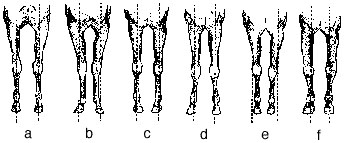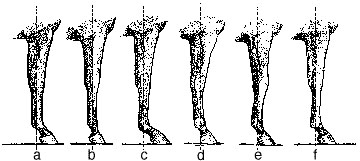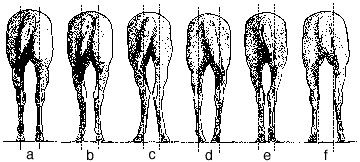It is difficult to over-emphasize underpinning (feet and legs) when appraising the worth of a horse. Except for breeding stock, horses are useful only when in motion. In a very real sense, the horse is an athlete. Any physical handicap that causes it to be clumsy, use excessive energy to perform a task, be hard riding, lack strength or speed, or wear excessively, decreases its potential usefulness.
Good action is determined largely by set of the feet and legs, slope of the shoulders and pasterns, and shortness of back and coupling relative to length of underline or belly. Good performance reflects structural straightness, physical fitness and confidence gained from systematic training.
Breeders or prospective buyers can save much time by avoiding horses whose potential is limited by physical handicaps, such as crooked legs, if they become proficient in identifying handicaps and allocating their resources accordingly.
Some physical handicaps are "acquired" through faulty diet or injury, but probably far more of these are claimed than actually exist. In most cases the condition is genetic and must be charged to the sire and/or dam. For this reason, breeding animals, especially stallions, should be free of major conformation defects.
Correct and incorrect leg set
Correct leg set implies "a leg under each corner of the body," accompanied by adequate, straight bone with short cannons; long, correctly sloped pasterns and medium-sized, balanced feet.
A horse that stands correctly will almost always move correctly. Conversely, one that stands crooked must move likewise.
Front legs
A plumb line dropped from the point of the shoulder should bisect the knee, cannon, ankle and foot (Figure 1A). One dropped from the arm should bisect the forearm, knee, cannon, and fetlock, and pass behind the heel (Figure 2A). The pasterns should be compatible in length with breed requirements, slope at an angle of 45 degrees, and join the foot without changing this angle.
Figures 1B through 1F and 2B through 2F show common defects of front leg set that affect action.

- Straight legs, good front.
- Splay-footed.
- Pigeon-toed.
- Knock-kneed, narrow front, base wide.
- Base-narrow.
- Bow-kneed

- Correct, good bone.
- Pastern too straight.
- Pastern too long and flat, angle different than foot, "coon-footed."
- Calf-kneed, short, straight pastern.
- Buck-kneed or over on the knee.
- "Tied in" or fine bone below the knee
Splayed feet and pigeon toes are quite common and affect action in proportion to their degree. Knock knees, bowed knees and base-narrow defects are less common but affect action and predispose to unsoundnesses.
Short, straight pasterns increase concussion to the horse and rider, which seriously predispose the horse to unsoundnesses and induce fatigue to horse and rider.
Long, weak pasterns ride easily but affect action and are undesirable for good stops with roping horses.
Calf knees are common and detract from appearance, whereas buck knees are uncommon except with jumpers.
"Tied-in" below the knee or hock indicates inadequate tendon and ligament development for long, trouble-free service.
Hind legs
Bone structure of the hind leg determines, to a large degree, the set of the feet and legs, and to a lesser degree arrangement and shape of muscling in the hind quarters (Figure 4A). Correct leg set can't be achieved with crooked bones. Bone structure is genetically determined.
A plumb line dropped from the point of the buttock should bisect the thigh, gaskin, hock, cannon, fetlock, pastern and foot (Figure 3A). Viewed from the side, it should contact the back of the hock, cannon, and fetlock (Figure 4B).
Figures 3B through F and 4C through F show common faults of hind leg set.

- Straight legs.
- Slightly cow-hocked.
- Extremely cow-hocked, splay-footed.
- Bow-legged or bandy-legged or "too wide," pigeon toed.
- Base-narrow or stands close.
- Base-wide or stands wide

- Correct skeletal structure.
- Correct leg set.
- Sickle-hocked or too much set.
- Post-legged or too straight, "coon-footed."
- Camped under or stands under.
- Defects of this magnitude should not be propagated
Almost all horses display cow hocks to a degree. Some horse owners prefer that hocks point slightly toward each other with the feet pointing slightly outward. This is insurance against wide hocks or bandy legs.
Noticeable cow hocks are undesirable both from the standpoint of action and appearance.
Bandy legs or wide hocks seriously deter collected action and predispose to unsoundness.
Sickle hocks are quite common and are serious because of the stress placed on the hocks in performance and the many unsoundnesses that are associated with them.
View a stallion with sickle hocks with concern.
Boggy hocks usually are seen with post-legs.
Correct and incorrect action
Correct action


The feet and legs of a horse at the walk or trot should move straight ahead parallel to an imaginary center line in the direction of travel. The feet should rock upward from the heel and break over squarely at the toe and should rise with a snap. They should be carried forward in a straight arc with the highest point of the arc occurring at the center of travel or when the supporting leg is passed. They should be set solidly and squarely on the ground with toes pointing straight ahead. Any deviation from this procedure is a defect of action. See Figures 5 and 6. This is not to say that all good horses must have perfect action. Many compensate by intelligence, willingness, and practice; however, correct action would make them better horses.
Some common incorrect actions



- Winding or rope walking. A tendency to swing the striding leg around and place it in front of the supporting leg (Figure 7).
- Dishing or winging in. The striding foot swings inward in motion, then outward again at completion of stride (Figure 8).
- Interfering. Striking the supporting leg, usually near the fetlock with the foot of the striding leg (Figure 8).
- Paddling. An outward deviation in the fore foot and lower leg at flexion (Figure 9).
- Winging. Exaggerated paddling, most noticeable in high-going horses.
- Forging. Striking the heel or undersurface of the shoe of a forefoot with the toe of a hind foot.
- Rolling. Excessive lateral shoulder motion as with wide-fronted horses.
- Pointing. A low, long stride.
- Dwelling. A perceptible pause in the flight of the foot before it reaches the ground.
- Trappy. A quick, high, short, jolting stride.
- Pounding. Heavy contact, sometimes resulting from a heavy stride.
Specific effect of leg set on action and unsoundnesses
- Pigeon toes tend to cause paddling or winging.
- Splayed feet encourage dishing or winging in and may result in severe interfering and permanent injury.
- Long, weak pasterns and shallow heels cause an irregular stride and may predispose to ringbone (Figure 10).
- Short, straight pasterns and shoulders and deep heels are accompanied by a stilted, trappy stride and a tendency toward stiffness and sidebones (Figure 11).
- Long forearms, short cannons and sloping pasterns are conducive to long, springy, true strides and limbs that wear well (Figures 5 and 6).
- Calf knees increase concussion and encourage a pounding gait.
- Buck knees cause unstableness. When accompanied by long toes, they tend to cause stumbling.
- Knock knees predispose to interfering.
- Bow knees usually cause undue weight on the outside of the front feet, which tends to hasten sidebones.
- Sickle hocks seldom accompany balanced conformation and motion. They must bear a disproportionate share of weight; therefore, spavins and curbs tend to develop.
- Post legs are less common than sickle hocks but are equally serious. They seldom ride easy, are prone to crampy, boggy hocks and tend to cause low, skimming strides.
- Bandy legs usually are unsteady or "limber hocked" and predispose to most unsoundnesses of the hock.


Straight underpinning does not guarantee a good performing horse, but it increases the probability of good performance.